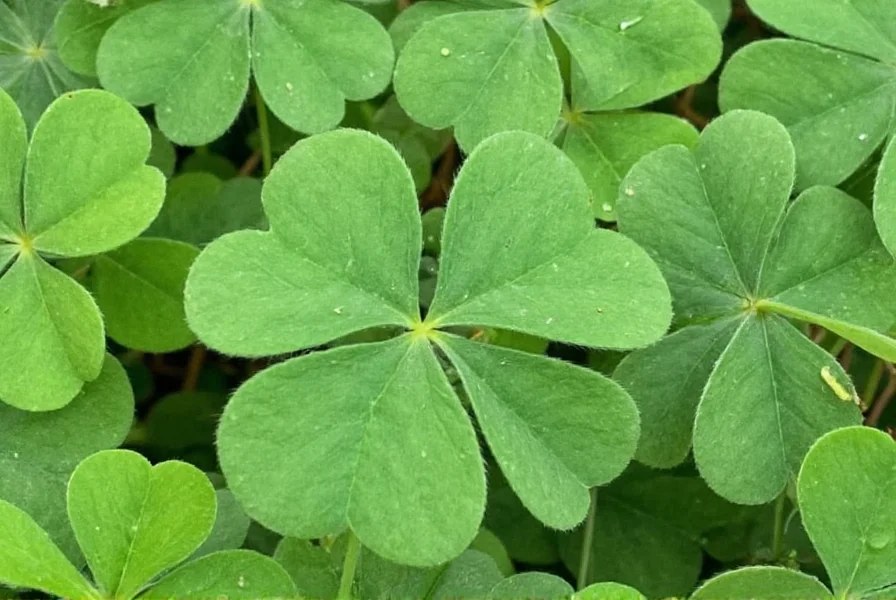Clover Key represents an important advancement in forage legume development, providing farmers with a reliable option for pasture improvement and soil health management. As a selectively bred cultivar of white clover, it maintains the characteristic three-leaf structure while offering enhanced agricultural performance traits that address common challenges in livestock farming and sustainable agriculture.
Understanding Clover Key Characteristics
Clover Key distinguishes itself through several key botanical features that make it particularly valuable in agricultural settings. This cultivar features medium-sized leaflets with a distinctive white crescent marking, characteristic of many white clover varieties. What sets Clover Key apart is its stolon density and rooting pattern, which contribute to its exceptional persistence under grazing conditions.
Unlike some white clover varieties that struggle in drier conditions, Clover Key demonstrates improved drought tolerance while maintaining its nitrogen-fixing capabilities. The plant typically reaches a height of 6-12 inches, making it suitable for both rotational and continuous grazing systems. Its flowering pattern provides consistent nectar sources for pollinators throughout the growing season, supporting biodiversity on agricultural lands.

Agricultural Applications of Clover Key
Farmers incorporate Clover Key into pasture mixes for several compelling reasons. Its nitrogen-fixing properties reduce the need for synthetic fertilizers, potentially lowering input costs by 30-50 pounds of nitrogen per acre annually. When properly managed, Clover Key can constitute 20-30% of a productive pasture mix, significantly enhancing forage quality and livestock performance.
The cultivar's growth habit makes it particularly well-suited for mixed sward systems with grasses like perennial ryegrass or tall fescue. Clover Key establishes relatively quickly—typically within 6-8 weeks under favorable conditions—and demonstrates good recovery after grazing events. This resilience makes it a valuable component in rotational grazing systems where pasture plants face frequent defoliation.
Comparing Clover Key to Other Clover Varieties
| Clover Variety | Height Range | Drought Tolerance | Grazing Tolerance | Best Use Case |
|---|---|---|---|---|
| Clover Key | 6-12 inches | High | Excellent | Rotational grazing systems |
| Ladino Clover | 12-18 inches | Moderate | Good | Hay production |
| Common White Clover | 4-8 inches | Low | Fair | Low-input pastures |
| Micro Clover | 2-4 inches | Low | Poor | Lawn applications |
Optimal Growing Conditions for Clover Key
While Clover Key demonstrates improved adaptability compared to standard white clover varieties, it performs best under specific conditions. The ideal soil pH range for Clover Key is between 6.0 and 7.0, though it can tolerate slightly more acidic conditions down to pH 5.5. It thrives in well-drained loam soils but shows reasonable adaptation to heavier clay soils when properly managed.
Temperature requirements for Clover Key include minimum germination temperatures of 40°F (4°C), with optimal growth occurring between 60-80°F (15-27°C). Unlike some clover varieties, Clover Key maintains reasonable productivity during summer months when adequate moisture is available. Farmers in regions with moderate rainfall (20-30 inches annually) typically achieve the best results, though supplemental irrigation can extend its productive season in drier areas.

Establishment and Management Practices
Successful establishment of Clover Key requires attention to seeding techniques and timing. The recommended seeding rate ranges from 1.5 to 2.5 pounds per acre when drilled into a prepared seedbed, or 2-3 pounds when broadcast. Seed should be placed at a depth of 1/8 to 1/4 inch, as deeper planting significantly reduces emergence rates.
For farmers incorporating Clover Key into existing pastures, frost seeding during late winter often yields the best results. The freeze-thaw cycles help work the seed into the soil surface, improving contact and germination rates. When establishing new pastures, Clover Key should be seeded with compatible grass species at reduced rates to prevent grass competition from overwhelming the clover during establishment.
Economic and Environmental Benefits
The economic advantages of incorporating Clover Key into pasture systems extend beyond reduced fertilizer costs. Research indicates that livestock grazing pastures with 25-30% Clover Key content show improved daily weight gains of 0.1-0.2 pounds per head compared to grass-only pastures. This translates to meaningful production increases over a grazing season.
From an environmental perspective, Clover Key contributes to soil health through its extensive root system and nitrogen fixation capabilities. Each acre of Clover Key can fix 75-150 pounds of nitrogen annually, reducing the need for synthetic inputs while improving soil organic matter. The plant's deep stolon system also enhances soil structure and water infiltration rates, making it valuable for erosion control on sloping lands.
Common Misconceptions About Clover Key
Several misconceptions surround Clover Key and its performance characteristics. Some farmers mistakenly believe that Clover Key requires significantly different management than other white clover varieties, when in reality its management requirements are quite similar to other improved white clovers. The primary differences lie in its enhanced persistence and slightly improved drought tolerance.
Another common misunderstanding involves Clover Key's relationship to four-leaf clovers. While all white clovers occasionally produce four-leaf variants, Clover Key is not specifically bred for this characteristic. Its selection criteria focused on agricultural performance rather than rare leaf formations. Farmers should manage Clover Key for its proven agronomic benefits rather than any symbolic or novelty characteristics.
Practical Implementation Tips
When incorporating Clover Key into your farming operation, consider these practical implementation strategies. First, conduct a soil test before planting to ensure proper pH and nutrient levels. Clover Key performs best when phosphorus and potassium levels are adequate, as these nutrients support root development and nitrogen fixation.
Monitor established stands regularly for potential pest issues, particularly clover root weevil in regions where this pest is prevalent. While Clover Key shows no specific resistance to this pest, proper rotational grazing can help disrupt the weevil's life cycle. Additionally, avoid over-application of broadleaf herbicides, as Clover Key remains susceptible to many common pasture herbicides despite its improved agronomic traits.
Frequently Asked Questions
What is the difference between Clover Key and common white clover?
Clover Key is a selectively bred cultivar of white clover with improved persistence, drought tolerance, and grazing recovery compared to common white clover. It features a more robust stolon system and maintains productivity under heavier grazing pressure, making it better suited for intensive pasture management systems.
How does Clover Key benefit soil health in agricultural systems?
Clover Key significantly improves soil health through nitrogen fixation (75-150 pounds per acre annually), enhanced soil structure from its extensive stolon system, and increased organic matter. These benefits reduce fertilizer requirements while improving water infiltration and erosion control, making it valuable for sustainable farming practices.
Can Clover Key be used in lawn applications like micro clover?
No, Clover Key is not recommended for lawn applications. It grows taller (6-12 inches) than micro clover varieties specifically bred for lawns. For residential lawns, micro clover cultivars are better suited due to their lower growth habit and tolerance to frequent mowing.
What is the optimal seeding rate for establishing Clover Key in pastures?
The recommended seeding rate for Clover Key is 1.5-2.5 pounds per acre when drilled into a prepared seedbed, or 2-3 pounds when broadcast. When frost seeding into existing pastures, use the higher end of this range (2-3 pounds per acre) to ensure adequate establishment.
How does Clover Key perform in drought conditions compared to other clover varieties?
Clover Key demonstrates higher drought tolerance than common white clover but less than deep-rooted varieties like alsike clover. Its improved root system allows it to maintain productivity during moderate drought periods, though extended severe drought will still reduce its performance. Proper rotational grazing management enhances its drought resilience by allowing adequate root recovery between grazing events.










 浙公网安备
33010002000092号
浙公网安备
33010002000092号 浙B2-20120091-4
浙B2-20120091-4